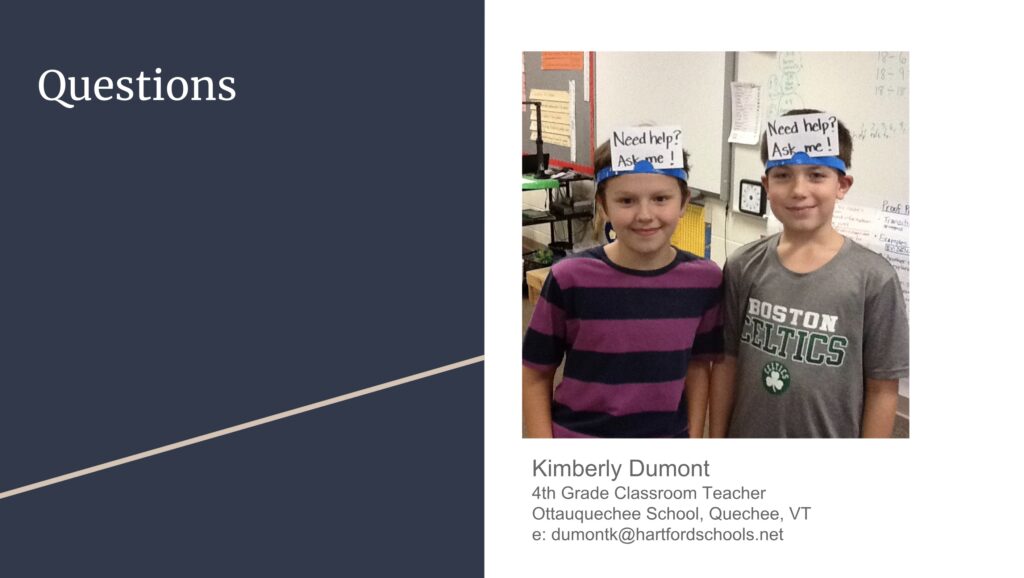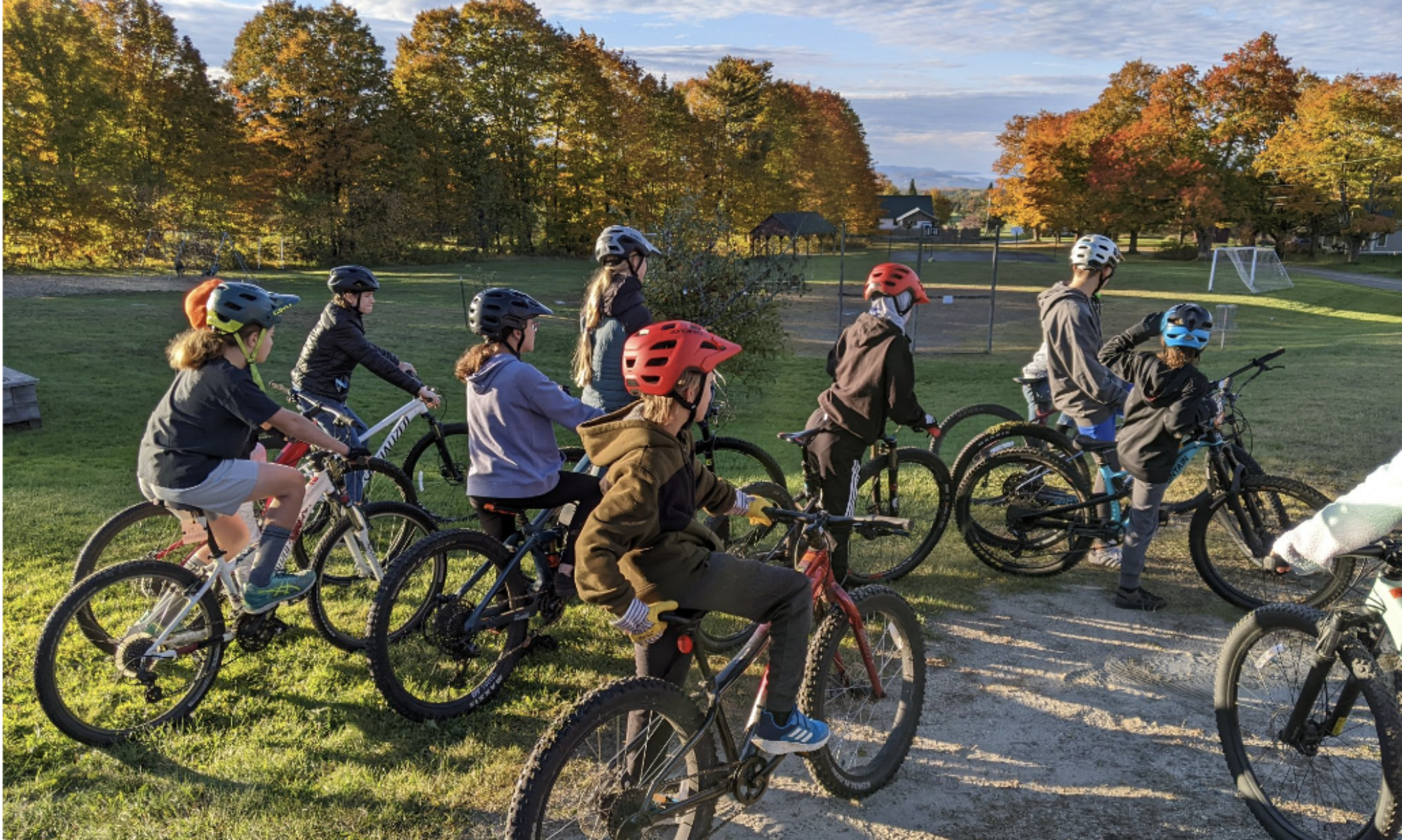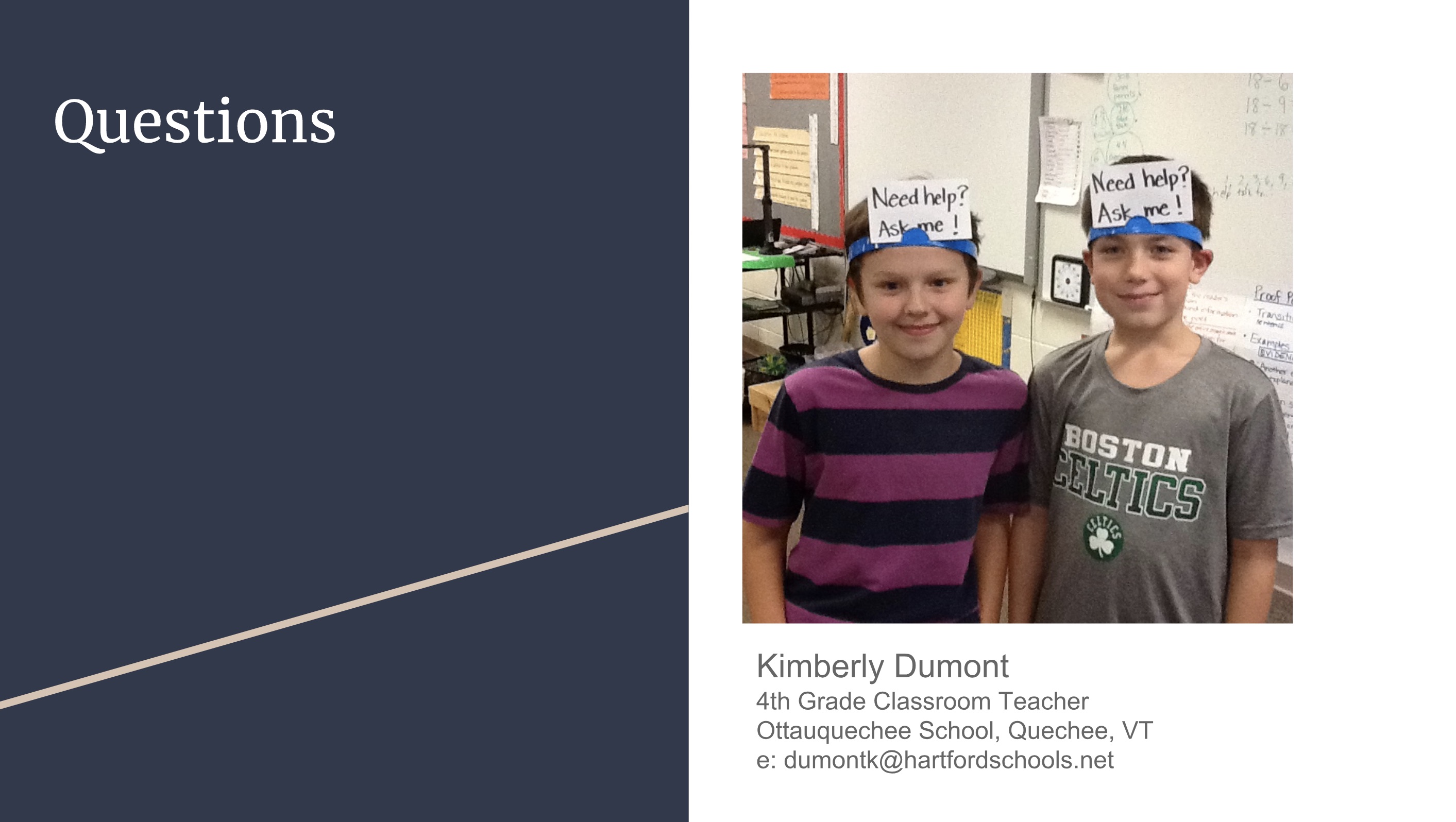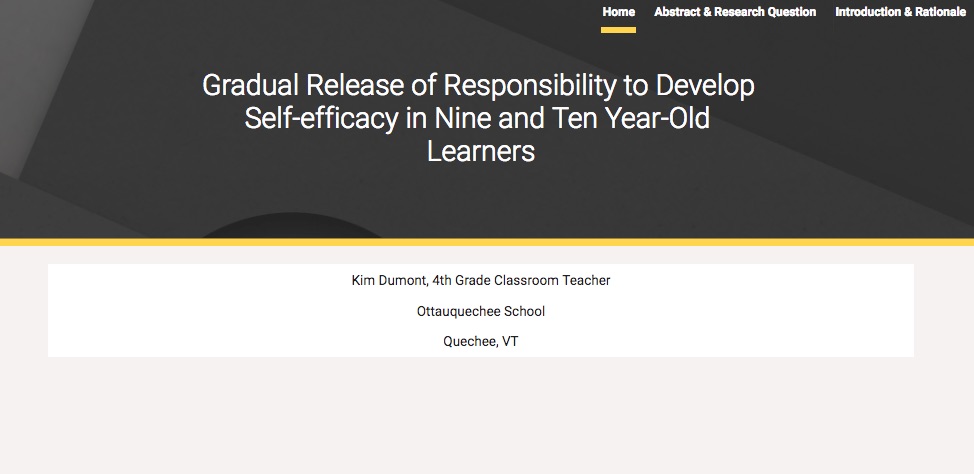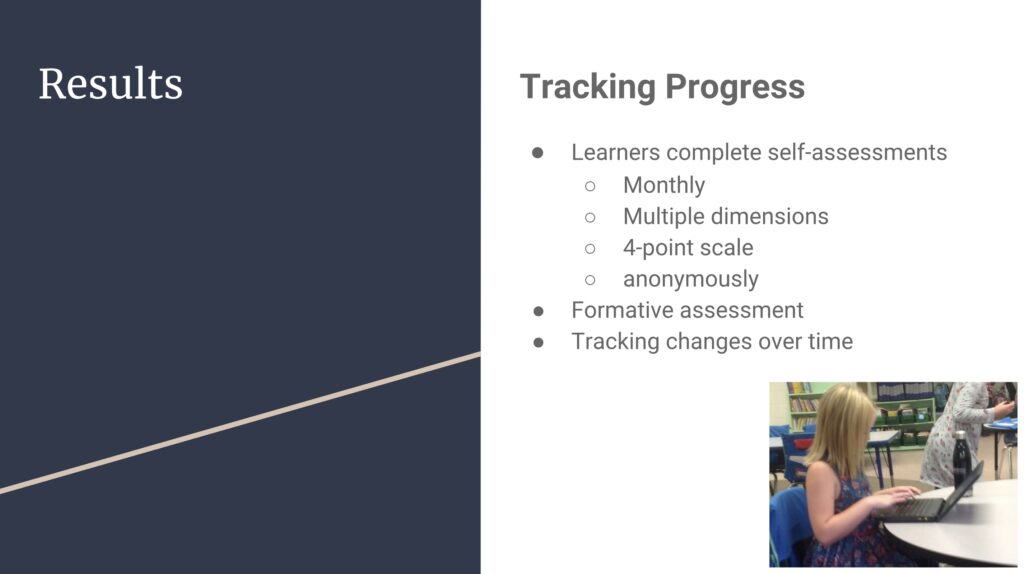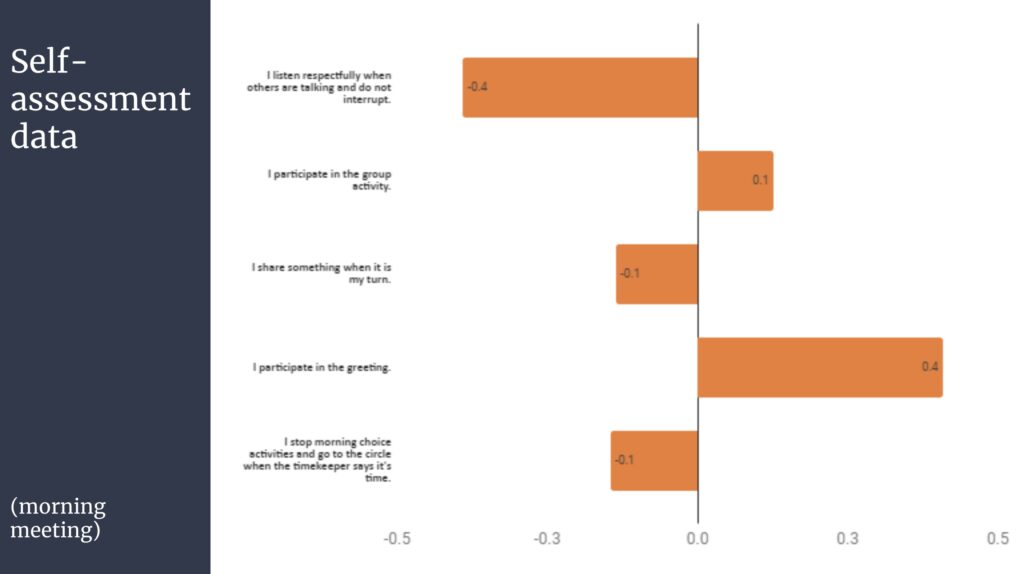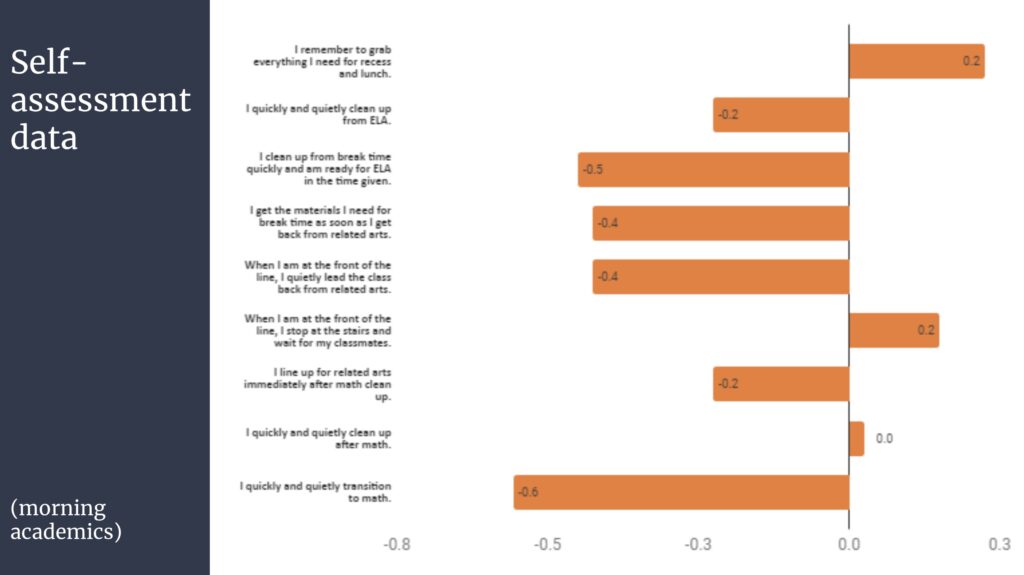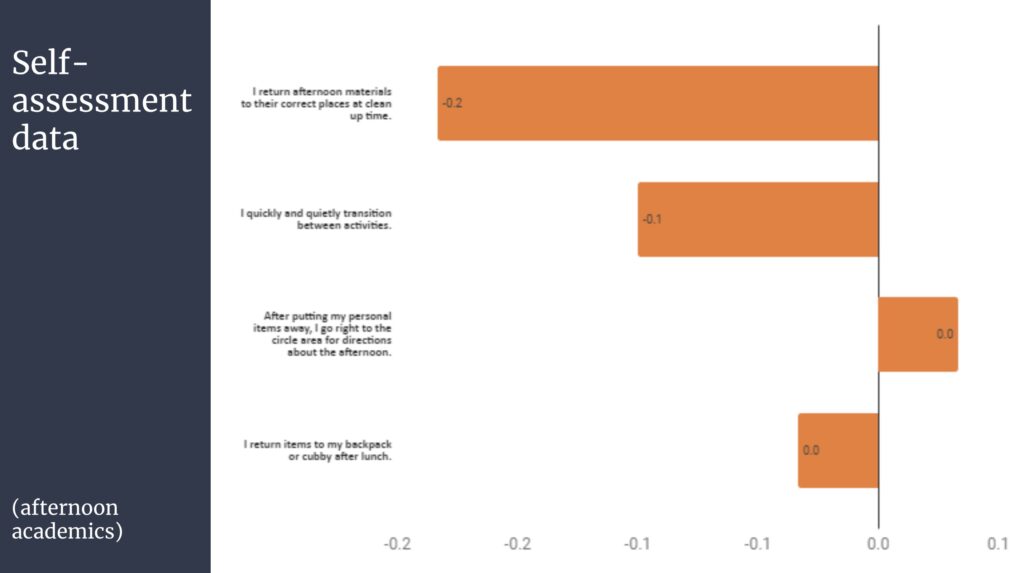Releasing responsibility in Ottauquechee
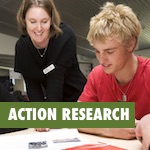 Ottauquechee Elementary School teacher Kim Dumont had a vision. She wanted to build her students’s self-direction and self-efficacy. She wanted students to feel like leaders of their classroom and their own learning. Over the summer, with the help of a week at Vermont’s Middle Grades Conference, Dumont put together a plan to help her fourth grade students learn self-direction and self-efficacy.
Ottauquechee Elementary School teacher Kim Dumont had a vision. She wanted to build her students’s self-direction and self-efficacy. She wanted students to feel like leaders of their classroom and their own learning. Over the summer, with the help of a week at Vermont’s Middle Grades Conference, Dumont put together a plan to help her fourth grade students learn self-direction and self-efficacy.
An action research plan was born.
This fall, she launched that plan, helping to build her students self-direct and efficacy through modeling and through releasing responsibility. Here’s the Google Site where she’s documenting her research:
The results
She presented the results of this research over the first half of the school year at the 2019 Middle Grades Conference. You can either watch Kim’s presentation in the video below, or read how it went, in Kim’s own words, below.

“Good morning, thank you all for being here. I called my presentation “Letting Go”, because I’m trying to give control of classroom operations to my fourth graders.
This is really a journey that we are all on together. I wanna introduce our cast of characters.
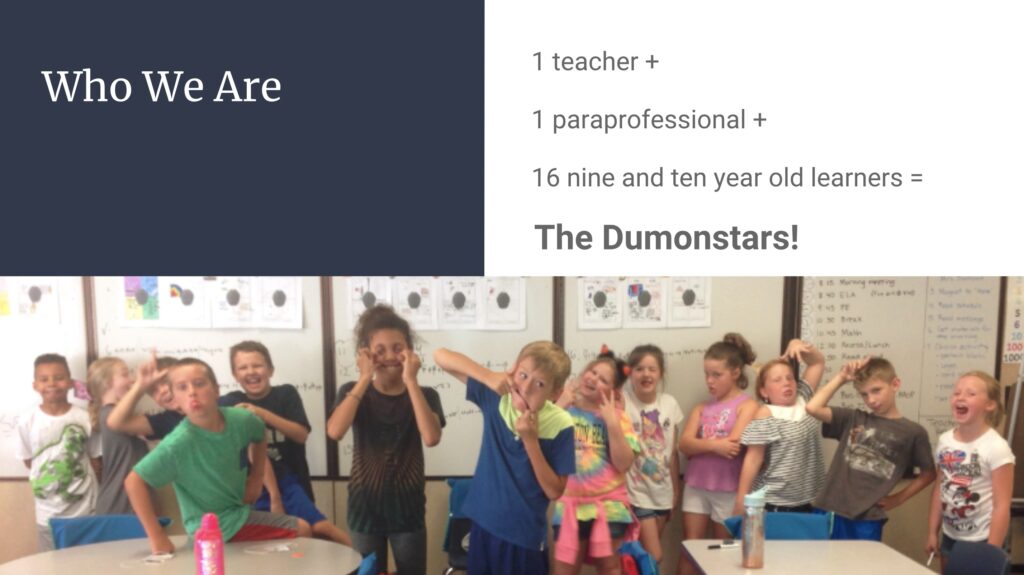
As you can see, they really are characters. I don’t know about other grades, but fourth graders, they won’t take a serious picture if you don’t promise them the goofy one. So here’s the goofy one. In the classroom everyday, it’s me, a wonderful paraprofessional who works one on one with one of my students, and 16 nine to ten year old learners. At the beginning of the year, they gave themselves the name — team name — the Dumontstars. And we really do use that name. And so there they are.
Our story begins with my belief that fourth graders need to feel ownership over their classroom and their learning to get the most out of school.
It’s really the foundation for this. My goal is that the class will run everything for the entire day and I won’t say a word to them. We’ll call it the silent day. The next point is that I will gradually release responsibility for the running of the classroom to the students and promote self-efficacy.
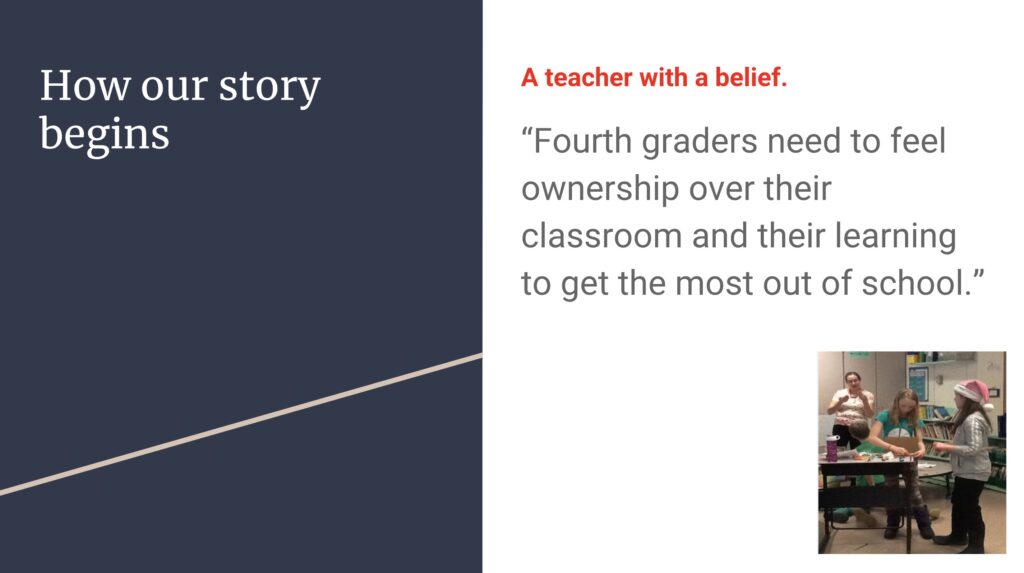
This really came about through MGI in June. We talked a lot about identity and self-efficacy, and how important it is for students to feel that ownership and feel that they can succeed. Really that’s what self-efficacy is — the belief that you can succeed.
The other inspiration was the book Learn Like A Pirate: Empower Your Students to Collaborate, Lead and Succeed. If you haven’t read it, it’s a fantastic book. I highly recommend it. Paul Solarz talks about his own classroom and his experience releasing responsibility and also just about the “silent day”.
The students that read it were like, “Oh, I can do this.”
With these fourth graders, I hear they’re going to be a really good group. We’re gonna try to do this. So, that’s what our plan was with gradually releasing responsibility. I was hoping to show an increase in their self-efficacy in their classroom ownership.
To put the plan into action, I wrote a list of routines, the rituals that they need to do everyday.
At MGI, you certainly have all the time to think and you’d come up with the best-laid plans and introduce them, “This day, day one, August 28th.”Okay, we’re going to be doing this, this, and this.” And these are the days they are going to be able to do it on their own or self-directed, and this is how we’re gonna know that they’re doing well. Of course with MGI, everything seems all very rosy and wonderful and most of this happened similar to what it says here.
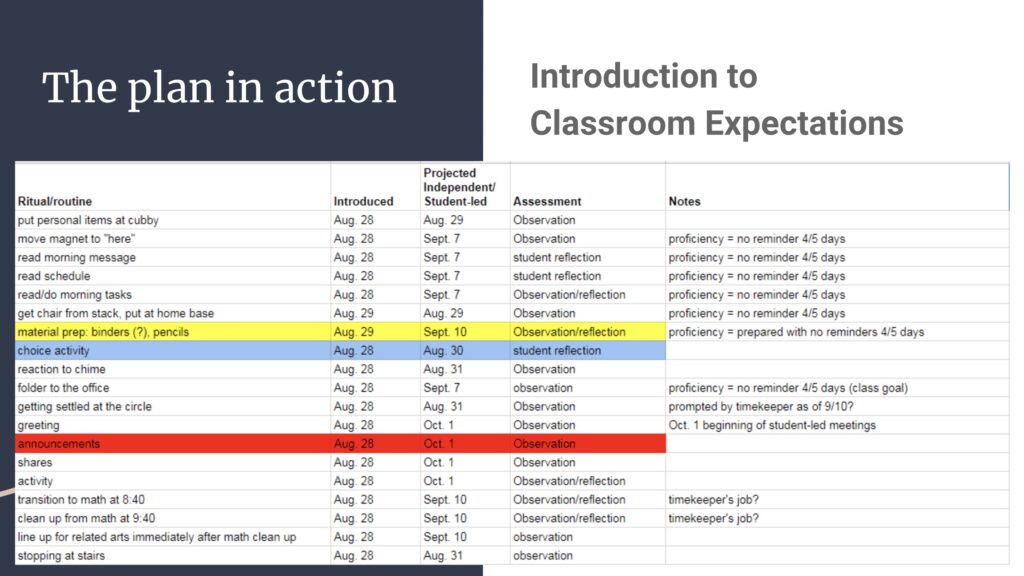
The red indicates things that we just took out. It wasn’t working for us. Blue was something that we had to change because again, it didn’t go quite as expected. Yellow is something, well, we misses our date and missed our target were still working on it, and that’s okay.
This isn’t the whole list, this is just a snapshot of it. I was going through, I’ve just seen, what do we have to do? What can we change based on what we need?
The other part of this was to introduce self-efficacy.
This was new language. It’s not something that they’ve ever heard. So we did that through first a self-assessment and all they need to do is fill in statements, the ones that Chris Stevenson has developed and have used at MGI, and you’ll see that on that on the next slide, what those statements are.
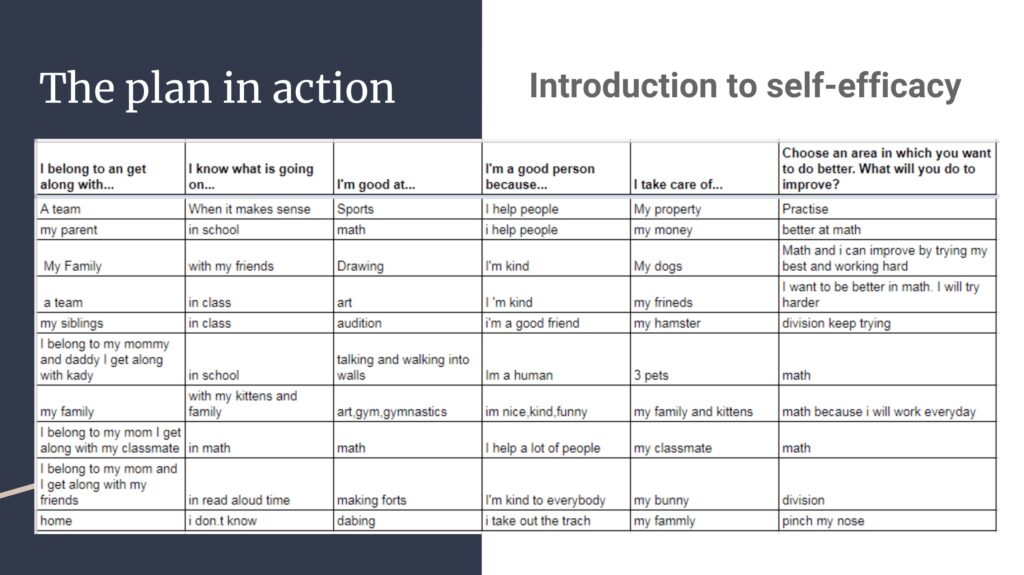
So they did that before we even started talking about self-efficacy and what is that, what does that mean. They just filled in statements: “I belong to and get along with…” So they were just really thinking about their own identity at that point.
We also read the book The First Rule of Punk, and we ended up Skyping with the author, Celia C. Perez.
It was just an amazing experience all around. The reason we used this book is because the main character, Malu, is talking about her identity, trying to figure out who she is. So we looked at self-efficacy through her lens.
Zines!!!
We also made zines. If you’ve never seen a zine, they’re just about the cutest little thing.They are mini-magazines and one of them is a model based on Malu and her own, her self-efficacies. So, we talked about hers and then we kinda matched them up to the model. Then I made one for myself as a model, and because I felt if they were letting me know about them, I was going to let them know about me.
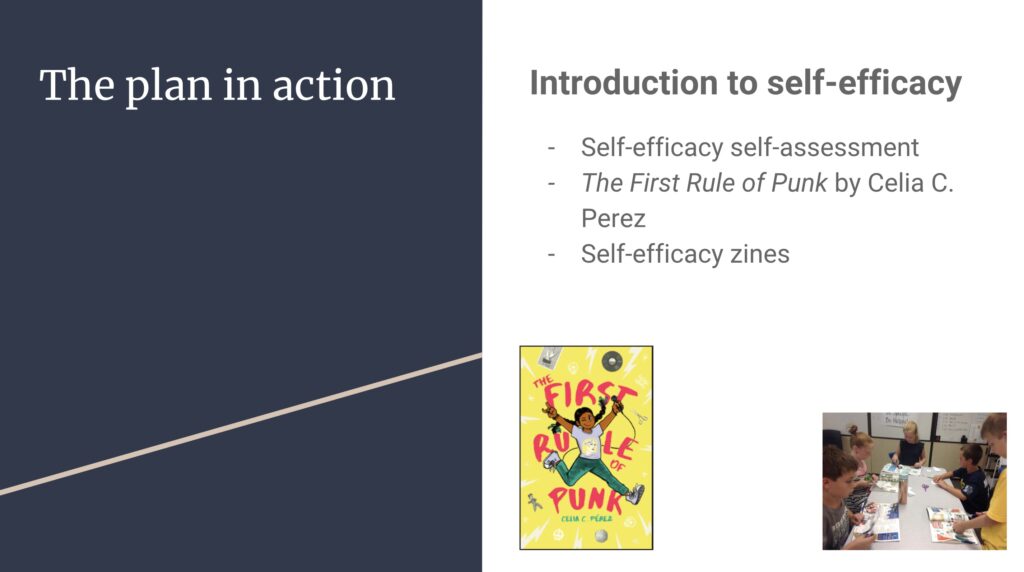
And so there’s a picture of them all working diligently to cut up words and letters that represent them choosing their little own self-efficacy zines. They love making zines. Once we started, there were zines everywhere all the time for everything. (Just as a warning if anybody decides to do that!)
These are some of the results from the first self-efficacy self-assessment that they did.
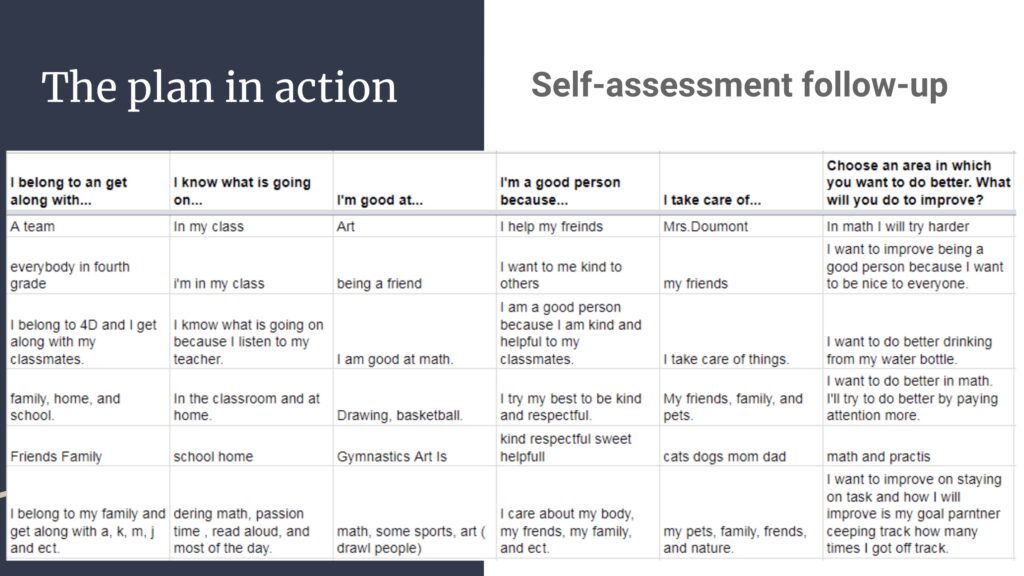
And as you can see, they just have to fill in, finish those phrases. A lot of them are about their families and scores for Math comes up a lot as far as things they need to get better at and how they’re going to do that. This is exactly what they wrote. You might notice the “pinch my nose” as the things they wanna get better at. But you know what, fourth graders, you know them.
This first time, it was really amazing that most of them could write something. So they are feeling that they can be successful, in some ways. We don’t see a lot of school. But this is like the third day of school, so not surprising that they’re not yet feeling that they’re successful at school.
Then in the follow-up though, we see a lot more mention of the classroom environment from the school
Things that are happening in the classroom that they feel that they are having a higher level of self-efficacy in the classroom.
Yes, one student, bless her soul, did write, “I take care of Mrs. Dumont.”
They’re clearly feeling a strong connection with the classroom while with their friends and what we’re doing at school. And so after four months, that’s exactly what I was hoping to see.
The other way that they’re taking ownership is that everyone in the class is entitled to get the group’s attention pretty much any time as long as it’s worthwhile.
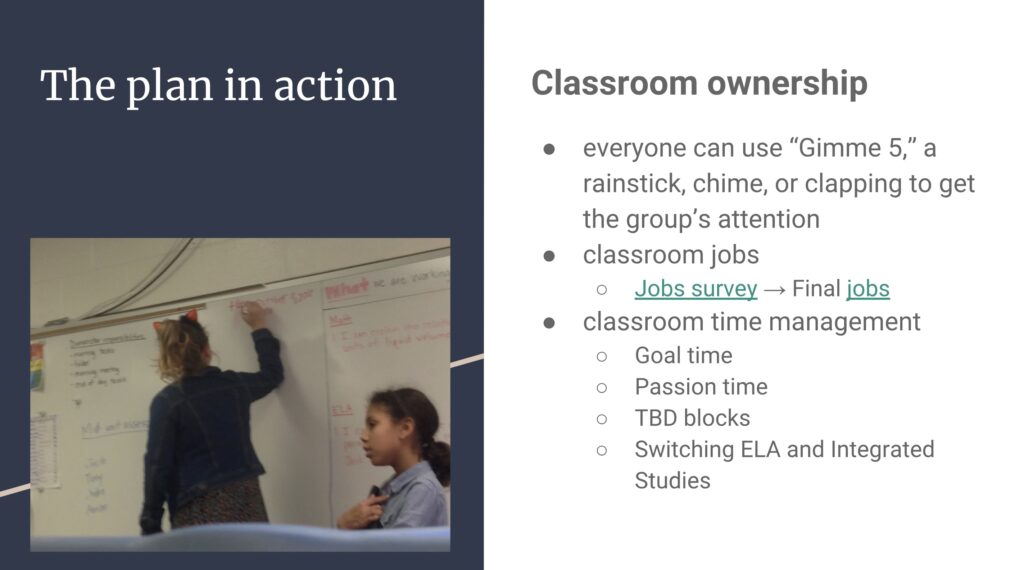
We’re working on that right now. They really love that chime, they love clapping. They love getting the group’s attention for things that sometimes we have to say not that the whole group really need their attention. Well, we do that privately. It’s not like, Hey, you don’t need everybody’s attention. But I think it’s really important for them to know that their voice is powerful, that theirs are just as important as mine. And so if they need the class’ attention, they’re welcome to get it. And like I said, they use it, they use it a lot. Sometimes more successfully than others, but they’re doing it.
The other way that they’re taking ownership, is we came up with classroom jobs.
The first round, they got to get any idea they want to. Nothing was thrown out.
So we have things like “Pillow Patroller”. Basically, we have pillows in the classroom, like somebody should make sure those are picked up. We need a pillow patroller. And so we have some really fine ideas. They did a survey where every idea was put on the survey and they would say yes or no. I want you to rate them. This is an example of one of the results.
Anything that got more than 50% of the vote was an automatic to go on the final list. Anything that got less than 50% of the vote was not in the final. Those that got 50% were put aside to be talked about as a whole group.
So, we voted; some of them stayed, some of them went. Pillow patroller didn’t make the cut but phone answerer did because, they do love answering the phone in the class.
That’s another responsibility that they are welcome to have.
Most classes, I don’t think do that, let the students pick up the phone and say,”Hello, Mrs. Dumont’s room, student speaking.” But I think it’s really important to want that job.
So our final jobs, and I just do wanna draw your attention to one final job because I think that it’s important to show. With the jobs, they also came up with expectations for each of these jobs.
There’s a job description so that they know exactly what they’re supposed to do. That came from them, I just typed it. One of the jobs is volcano monitor. I’m pretty sure that no other classroom ever has had volcano monitor.
We read the book My Mouth Is A Volcano and they recognize it themselves that they have a lot of kids who interrupt and erupt like a volcano.
They decided that one person should be in-charge of letting those people know that they’re being a volcano.
One student actually made a little volcano that says, “I am a volcano”. They take that very seriously and the other kids respond to it really well because they know that they chosen to have that person as the volcano monitor.
I think if I had gone in this with the jobs already created, which I’ve done in the past, that would not make the cut, it wouldn’t represent what they thought they needed.
That’s been really important lesson this year. I don’t always know what they need and they know better than I do. I just really love that job.
Something else that they are helping me out this year is taking the responsibility for is time management.
They have two blocks in the week; goal time and a passion time, that are completely student-led, student-directed. The students decided what their SMART goal is.They decided how they’re going to reach that SMART goal and are tracking their progress toward it. If they come to me and tell me,”Mrs. Dumont, I think I’ve reached my goal.”I’m just, “Okay, what’s your evidence?” They will show me either spelling words that they spelled all correctly that they have done with a partner. Or they show me a math journal where they’ve written beautifully because their goal is writing neatly so others can read it. So that’s really up to them. They have a goal partner who’s working on something similar and they help each other out.
The passion time is a time where they do a project that’s really their passion. I have helped them in projects ranging from World War I to make-up, and if it is used, you know,
they put natural products versus synthetic products.
So it’s really who they are and something that they’re really interested in and they really report to those two times; goal time and passion time.
The TBD blocks are just chunks of times where like, I’m not sure?
What do you want me to do with this time? What do we need to do to be successful? How should we use this time? They’ll say, “Oh, I think we should use it to”finish up that ELA lesson that we didn’t finish the other day.” Or, “We can use it for Math menu time.”
It’s really up to them how we use it. I think the power of their voices really came through in this last item.
One day, we had to finish ELA in the afternoon. We just didn’t finish it and it was one of those days where I like we have to get through this. So we did it and they said, “Mrs. Dumont, can we do this in the afternoon all the time?
“Can we always have ELA in the afternoon?” I said, “Why?” They said, “Well, after recess and lunch, “we’re a lot more settled down, than we are before recess and lunch.”
“We’re a lot more squirrelly and integrated studies is a time where we get to move around more.”Okay, so we put it to a vote and they all voted to do that change. So now we do the ELA in the afternoons.
Yeah, it’s not something that I would have thought of and there was a perfectly valid reason and they were able to explain it. I just thought that was really a highlight for me to know that they realized that their voices are as powerful as they are.
They even changed the schedule. I think that was really important.
Tracking progress
This is how we do it for self-assessments. We try to do it monthly, best-laid plans.
Really what we’re looking for is changes over time. So the next few slides, you’ll get to see some results. I’d go through that rather quickly because really what we’re looking for again is the trend.
So you’ll see some things that jump out.
The data set is small, so we’re kinda just looking for those trends.
The right side indicates the ones that they feel like they’ve improved on. The left side, kinda we’re slipping backwards a little bit. You can see morning, they’re feeling pretty good except for that forgetting their materials.
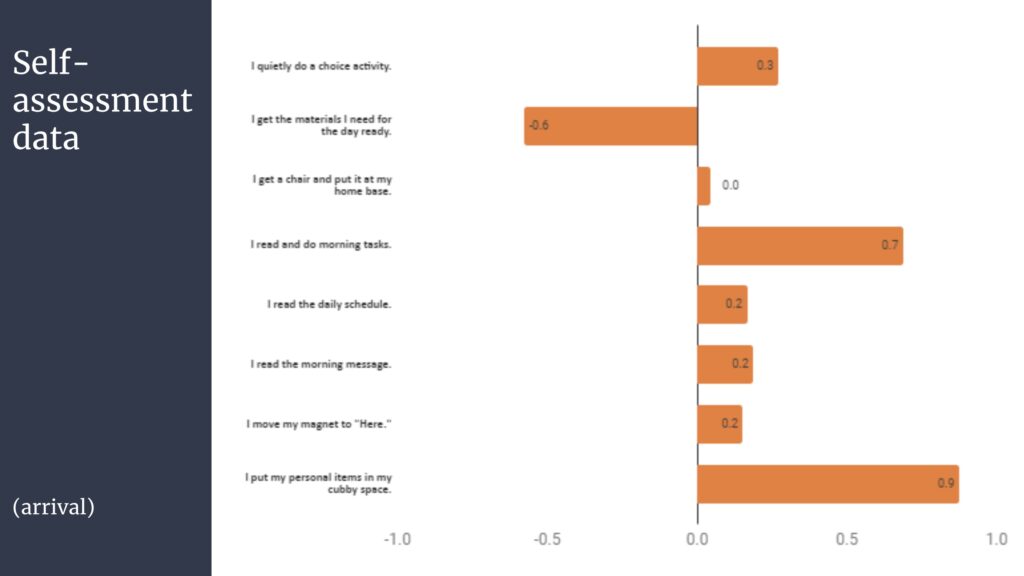
Next one is these changes again aren’t that big, but again, respectfully listening to each other. That’s where that volcano monitor really comes in handy!
A lot of these are morning academic times and transitions and things are becoming loud and slow, as you’ll see teachers feel the same. These are really, because the scale is so small, this looks big but really these are about zero.
Then that one really jumps out right at the largely negative, not cleaning out their cubbies.
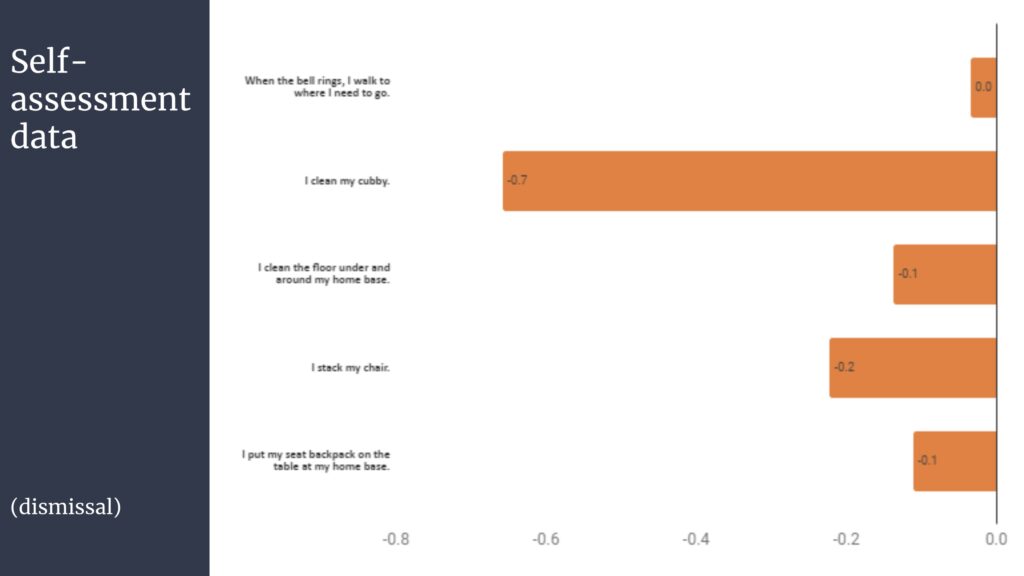
That goes along with the observations that we made as teachers where they’re forgetting their morning materials and they’ll be back like, “Oh, no, I don’t have an my math journal.” “I don’t have a pencil.”
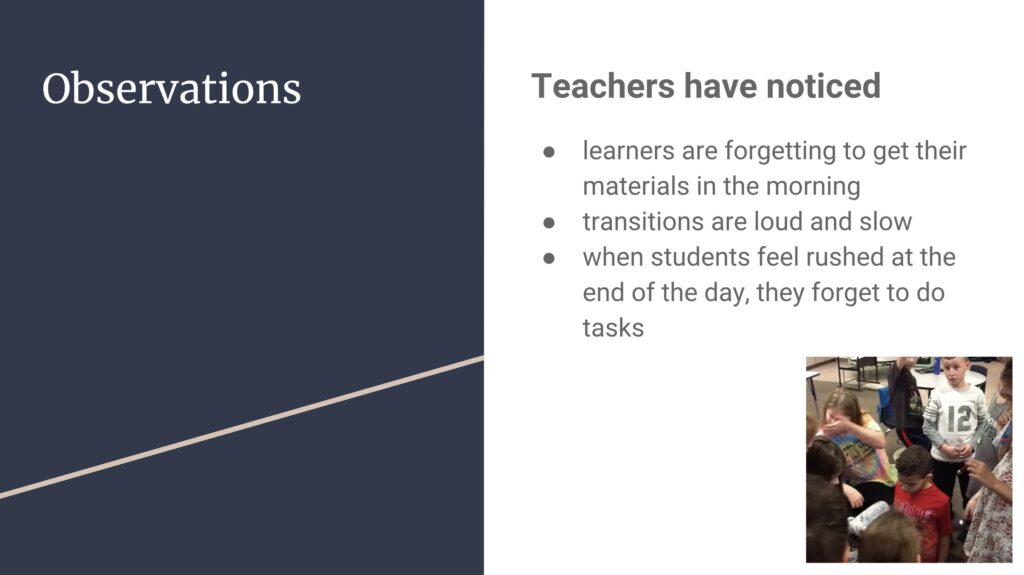
During the transitions, loud and slow and when they feel rushed at the end of the day, they forget to do stuff. There’s that cubby thing they have a bunch of stuff and they’re trying to pack it all up and the cubby is the last thing that really gets attention.
So they’re very honest.
The data show that they showed improvements in the morning and they arrive and know what they’re doing.
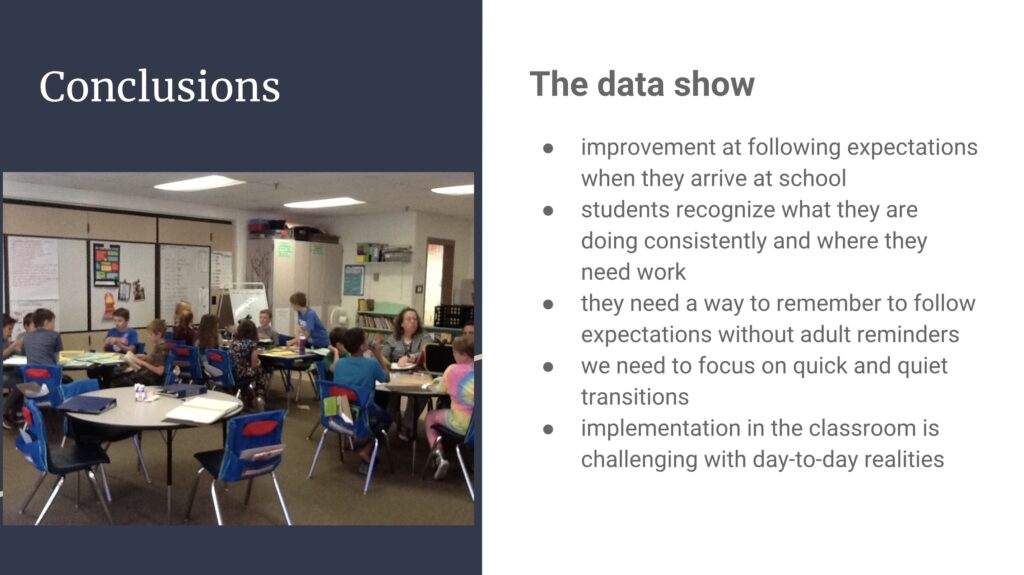
They’re writing what they’re doing well and what they need to work on, and they need a way to remember it without adult intervention because otherwise that defeats the purpose.
They’re trying to gain responsibility and that independence. Implementation can be difficult. At the end of the day, when it’s time to clean cubbies, they’re kinda held up with other stuff.
So we had to come up with a plan. They decided… I put this data, I just said, “Here’s what we’re seeing, here’s what you’re seeing, “what should we do?”
So they decided that they wanted a checklist so they could self-monitor, so now they have all of those metrics on their little checklist. Here’s students filling it out. She was doing that, I didn’t tell her to do that. She was totally doing it and I just snapped a picture.
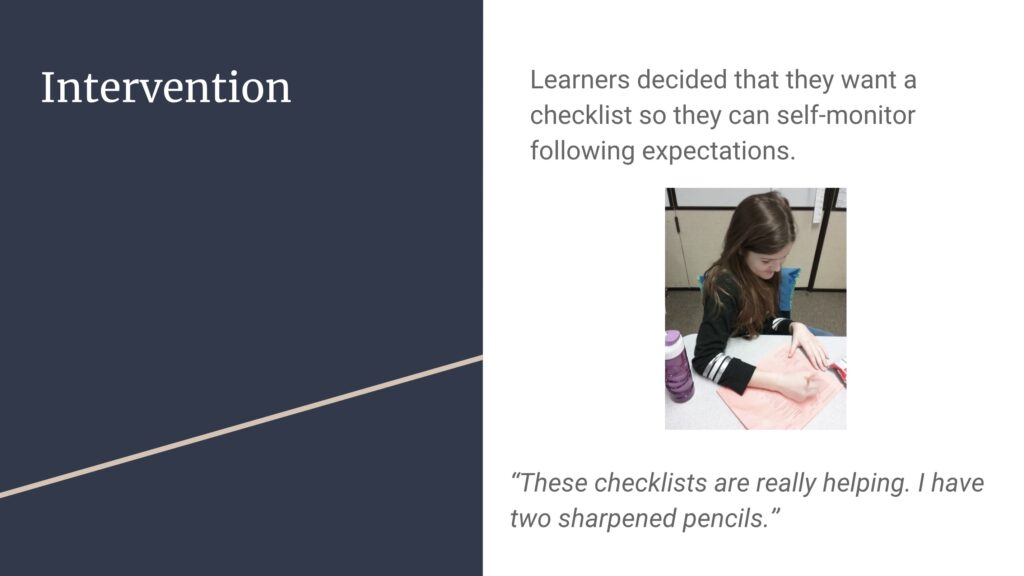
You can see that one student felt particularly fantastic that he has two sharpened pencils. Really great.
So we have made progress toward the silent day.
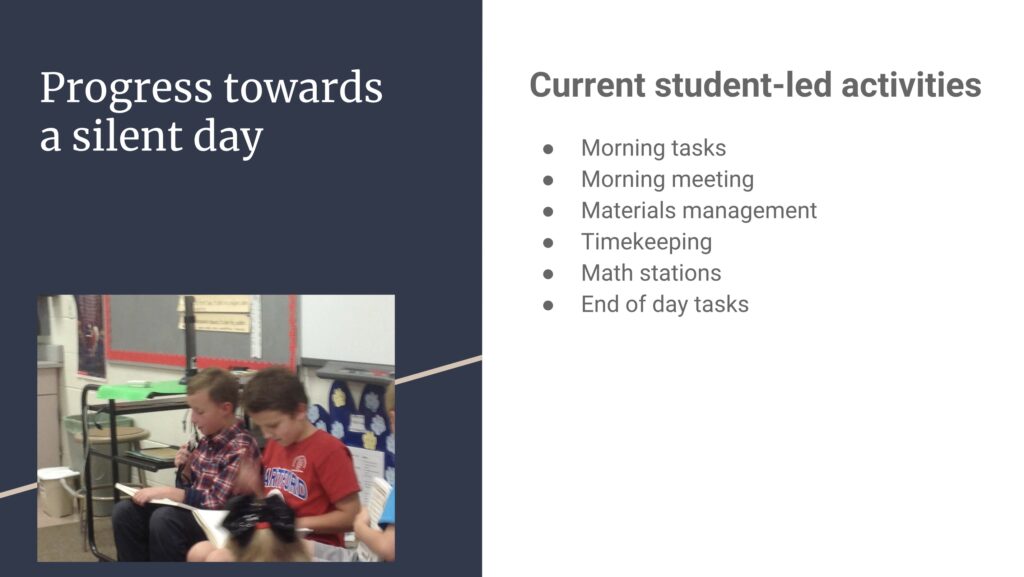
These are the current student-led activities that I could be out of the room and it would still happen. Math station, there is a teacher station, but other than that, if they’re not with a teacher at the station, they’re choosing their own independent work through the math menu and they’re making their own decisions.
They did have a silent morning in October!
I said nothing and they did everything. It’s just how seriously they took that. They took their responsibility so seriously and they were well-behaved on that day heading for their classroom to music than I think they ever had in the hallways because they knew that it was up to them, it’s their responsibility.
That leads to our next steps.
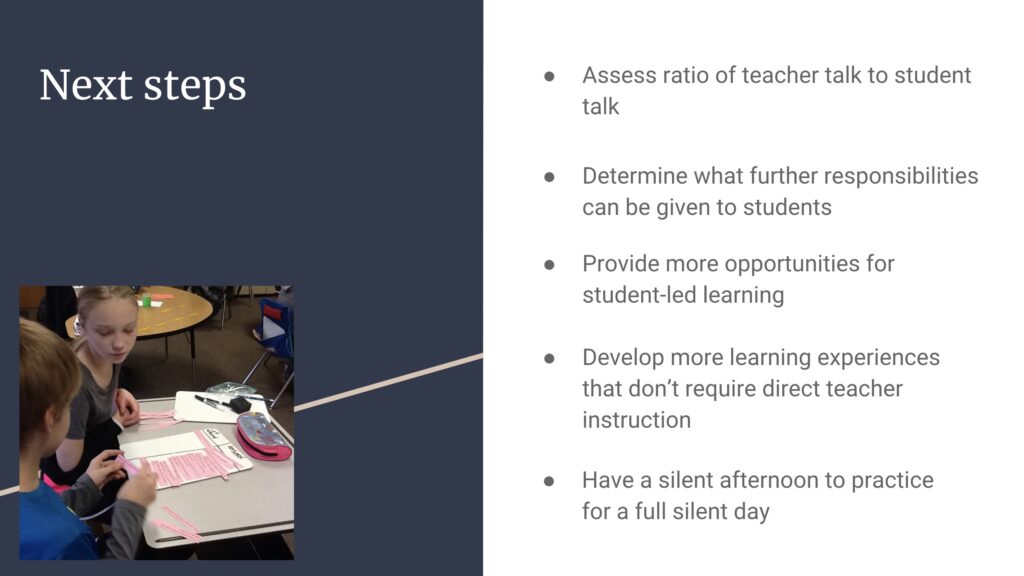
I did assess the student to ratio talk to make sure that their voices are heard much more often than mine. If they’re gonna take control, they need to have that. Determining what
responsibilities they can have as far as academic work, anything else, I’d asked them for input.
They were very interesting.
There were things like we need to be respectful of each other. We need to, you know…Which is all great. It’s all great.
But then it’s like, okay, what about in the academic part?
They said, “Oh, well maybe we should have students teach some lessons.” “We could have them teach with you.” So then we came up with all sorts of great ideas.
Now, it’s just giving them those opportunities. We have a plan for a silent afternoon, and it’s going to be next Friday that we don’t have skiing, we have a ski program in our school. They chose Friday afternoon because they thought it was logical because there were three chunks of times and mostly it’s student-directed now, so that’s a good time to practice.
That’s our plan going forward.
